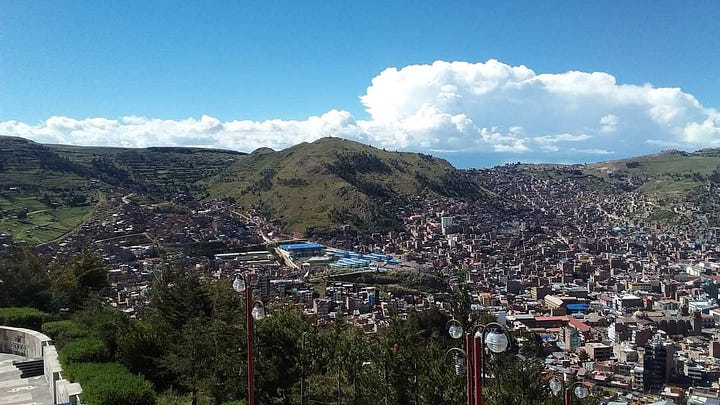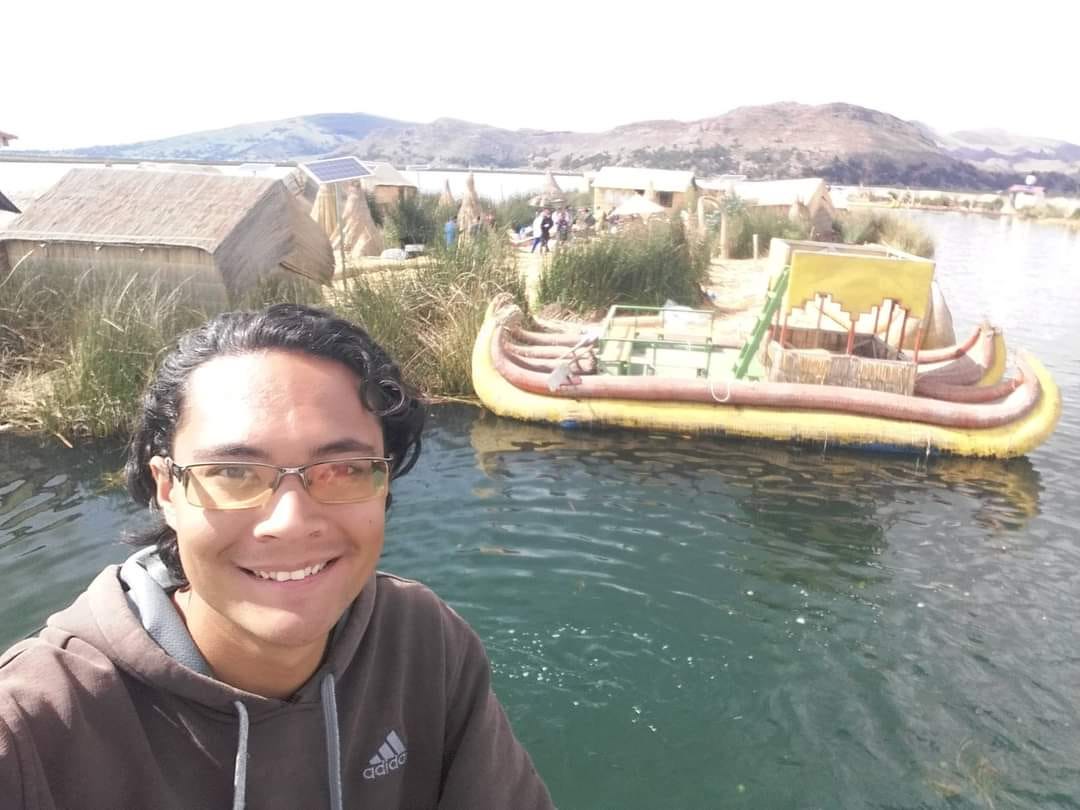Feb-March 2019
I get a great view of the coast and the endless sprawl of Lima as the plane comes in for a landing. It’s a sunny day. Even though its February, because it’s the Southern Hemisphere, Peru is in peak summer. The airport was quite nice, I enjoy the A/C before walking out into the searing sun. The local bus is on the main road just off the central parking lot. They have signs to various neighborhoods. I get on the bus going towards Miraflores. It’s a really nice area along the coast and popular with tourism. I get dropped off at a main roundabout on Av. Jose Pardo. I think the hostel I stayed at changed its name because I can’t find it on the map anymore. I remember it sat on a cross section with a small park in front of it and just a few minutes’ walk to the coast.
Lima sits on a cliff. It can be a hike to go further down to the beach. You can walk all day along the coast. They are numerous parks and hang out spots with great views of the Pacific. The central area is called Larcomar. It has numerous shops and restaurants and a popular gathering point for sunsets. I keep walking down until I get to the Playa Agua Dulce. The beach is packed but it looks more local here.




Next day I walk to Huaca Pucllana. It’s not far from Miraflores. It’s an ancient pyramid before the Incan times and dates back from around 200 AD. It’s made out of clay and adobe bricks. Fascinating to see this existing right next to modern architecture. The structure was once part of a massive complex and is made up of various platforms. Would have been something else to see it at its peak.
There’s a Metro Bus in-between the highway that runs through like a corridor. You can buy a ticket before the turnstyles or there are signs showing you their app. The bus was quite nice and faster than the traffic. I don’t recall where exactly I got dropped off, but it was just outside the Centro Historico and the Plaza de Armas de Lima. On one side of the Plaza was the Cathedral and across from that the Government Palace. Through the gates you can see guards in formal uniform.





A few days later I take the metro bus again to the Santa Catalina neighborhood. There are many bus companies you can choose to travel around the country but I’m going to go with Cruz del Sur. They have good reviews. I’m going to Ica today and next to that is the Huacachina Oasis. It takes forever to get out of Lima. The traffic is pretty bad.
This region of Peru is all desert. Across the mountains, the jungles of the Amazon begin. The highway comes close to the coast at some points. Many areas here have small beach towns or resorts. In between those points are stretches devoid of civilization. A complete contrast to the city. Just nature, not even footprints. Its getting dark when we arrive in Ica. The bus terminal is just across from the central plaza. It’s about a 15min walk down the main road to the hostel I’m staying at called Ica Adventures 2. Pretty relaxed. They have a restaurant/bar and a patio lounge. Not many people today it’s very quiet. Sometimes it’s a blessing to have a dorm all to yourself. I finish the night with some laundry. If any of you have stayed extensively in hostels you can probably relate to washing your clothes in the shower or sink and hanging them to dry on the racks of your hostel bed haha.
In the morning it’s time to walk to Huacachina. The oasis is about 5km away and a straight shot down the road from the hostel. As I leave the center, the sand gradually increases as I get closer to the dunes. As soon as you leave the city limits the desert takes over. The road climbs in-between two dunes and then you see it. A serene little lake surrounded by palm trees. You can rent buggies. On the left in the distance, I see them flying up and down the sand. On the right you got people sand boarding. Looks really fun too. It’s early morning so some restaurants and shops are still closed. I hike up the sand dune on the right. Always a good workout climbing them. Every two steps you walk up, you slide back one. I sit on the top as things begin to heat up. The land reflecting the sun begins to turn into an oven. The sand becoming too hot for the skin. I feel the moisture in my body being baked away. The dunes roll into the horizon in varying waves like an ocean. It’s a beautiful sight.





I run down the sand dune. What takes nearly 30 minutes to climb I get down in 30 seconds. There is more life awake now in the village. I see people paddle boarding in the lake. Vendors are open. There are some tour groups going around. I walk past a restaurant, and I have to do a double take. The name of the place is called HuacaFuckingChina. What an interesting name for a business! The food looks good but it’s all at a tourist price.
I’m going to push on all the way to Lake Titicaca. It requires a night bus to Arequipa and then another bus to Puno. I’ll pass by the Nazca lines, but it doesn’t “call” me enough to book a flight to go and see them. There are too many amazing things to see in this country. I had heard about this island far out in the lake called Isla Taquile. They were having their own version of Carnaval soon and I really wanted to see that.
The bus leaves in the evening from Ica and goes through all the night until arriving at Arequipa after sunrise. Looking out the window, I see the Chachani Volcano towering above the city. At over 6,000 metres (near 20,000 ft) its snowcapped summit provides an imposing trek for any serious hikers. I wait at the bus terminal for the connection to Puno.
It’ll be many more hours to get to Lake Titicaca. The road climbs in elevation twisting and turning endlessly. We end up in some high alpine plateaus and lakes. The drop in temperature seeps into the bus. In the distance I observe small huts and shacks. Definitely takes a hardy soul to endure a life up here. I also get to see my first Llamas! They look so cool, just chillin.
We begin to descend from the mountains and come into Puno. The city is stacked onto itself in the lower elevated areas coming down the mountain and then lines the lake. From the mountain top I get a sweeping view of the highest alpine lake in the world. On the other side is Bolivia but I can’t see that country from here. At 3,800 metres (12,500ft), I do feel a slight lack in air breathing. I’m sure I’ll feel more acclimated in some days.
As soon as I walk out of the bus terminal, there are local people dancing in the street. I watch curiously at what’s happening. This is also my first time I see local people in traditional clothing. In Lima it was mostly western clothing. It’s easier to explain what they are wearing with some pictures. Depending on where you go in Peru, the traditional outfits will change:




I have a video from my phone as well. Not professional quality but it doesn’t have to be to capture the magic:
I’m the only foreigner out here and I don’t see any other tourists. I love moments like these where I get to observe local life in its purest form. I also don’t recognize hearing Spanish spoken all the time. The language sounds different. It’s actually called Quechua and it goes back to the Inca. Amazing. Living history. “Allianchu” is hello. Pronounced eye-eee-anch-ooo. Nevertheless, the language of hand charades and pointing gets me through.
I take a walk up through the streets and the elevation climbs quickly. I end up at a park close to where the mountains begin and enjoy the views.




Close to here in another courtyard is more dancing crowds. I walk in and sit amongst the locals.






The hostel was not far from the shore. I didn’t like this one too much. They were pushing hard to get me on a guided tour. Nothing wrong about a tour. I just prefer to go the local way and explore on my own. When you go out on the lake, there are tourist ferries and local ferries. I think the local boats are better. I walk to the pier and buy a ticket from the office to Taquile. There are a few office buildings and other companies offering tickets but to Taquile it’s a specific place. There are many places around the lake you can visit so you may feel spoiled for choices.
So, the next day I get on and we head out. Nearly all boats stop for a visit on the floating villages of Uros. They are a true marvel in ingenuity. The people are a separate indigenous group who built these islands to protect themselves from the Incas and Spanish. They are entirely constructed out of reeds! Stacked and tied together, they create a dry, floating haven that can even be maneuvered to new locations. It’s a ton of work to gather enough reeds to build a home. I’m blown away how they managed to do this. What a life. We stop at a few places and the locals come to greet us. They survive a lot off the tourism now. Some children show up and sing for us, hoping for a tip. There are tables set up for selling jewelry or trinkets. A few homes have solar panels but are mostly independent from modern amenities. The people live off the lake and whatever it provides for them.











After that we cross a wide expanse of calm water and come up to Isla Taquile. The island rises sharply over the lake and it is a hike to get up. The people live at the top with innumerable stepped terraces surrounding them until ending at the cliffs. Stay tuned for Part-2 where I talk about the festival on Isla Taquile, visit Cusco, Ollantaytambo, famed Machu Pichu, and take the long way back to Lima through the Amazon side of the mountains. Cheers!
-AbroadwithBrian










Brian, it was enticing to hear something about a country I always wanted to visit.
I also prefer to take a local approach when visiting new places, it makes me feel more connected and not like an ultimate outcast.
Do you use apps to find connections in the places you visit?